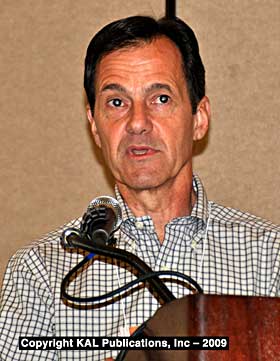All diesel fueled trucks, buses, trailers, and transportation refrigeration units operating in California, including those based out of state, are required by regulations to take steps to reduce air pollution.
The truck and bus regulations applies to just about 14,000 pounds gross vehicle pound rating operating in the state of California. The exclusions are emergency vehicles, military tactical vehicles, personal use motorhomes, solid waste collection vehicles and drayage trucks. It's pretty hard to find a vehicle that is not covered if it runs on diesel. Trucks and vehicles coming in from out of state would have to comply with the regulation, also.

The owner of the truck is responsible for all compliance with the law.
We have the definition of an emergency vehicle and we have changed that language. Whether a vehicle that is transporting fuel to supply a fire line, those miles would not be counted toward the definition of a low mileage or low use vehicle. Many of those vehicles, that's all they do, so almost 100% of their mileage may be for emergency use.
January 1, 2011 to January 1, 2011 to phase in particulate matter controls. Need to install the highest level PM exhaust retrofit. 2007 model year and newer engines are originally equipped with a PM filter.
100% of your fleet is going to have to have filters by January 1, 2014. Starting January 1, 2013, vehicles will start to have to meet NOx requirements.
The good news is there are no reporting requirements. You just drive and if you get popped and inspected, and if you're in compliance, you're fine.
If you drive under 7500 miles you don't have to do the NOx requirements. Those miles do not include any miles driven outside the state of California or any miles driven within the NOx attainment areas — primarily along the coast or in the northern part of the state. GPS must be used to track the vehicle to prove it doesn't leave the area.
There are incentives for buying and operating hybrids.
3 day pass: out of state fleets can come into California for three days at a time without being in compliance: one truck per fleet per year.
There are confusing regulations for small fleets (3 trucks or less). But the bottom line is they don't have to start doing anything for the first couple of years.
There is a compliance delay for reducing fleet size, a credit that will be in place until January 1, 2014.
If you have alternative fueled vehicles, you can use 0 as a PM emission factor and NOx the same as a diesel truck. Alternative fuel: propane, natural gas, LNG. Biodiesel is not considered an alternative fuel.
Agricultural vehicles, exclusively used in agricultural operations and to haul from field to first processor are exempt from PM and NOX regulations until 2013, provided they travel less than 10,000 miles per year.
Anything publicly owned is, of course, exempt from the regulations.
There is an Excel spreadsheet available to assist fleet owners to determine potential compliance paths. All it asks for is the model year of the vehicle and it will do calculations for you. The vehicle owner must determine which vehicles will be low mileage and other categories of operation. Miles traveled is not part of the calculation. (calculator)
Funding programs are available for truck fleets with 3 trucks or less; there is one program for 20 trucks or under.
There are going to be a couple of enforcement regulations. ARB inspectors in conjunction with the Highway Patrol at truck stops and weigh stations. Probably the one on the horizon is going to be the audit program. You are going to be required to keep records of your trucks, keep records of their compliance, and they can be audited. We've set the regulation up so audits would be an appropriate measure for compliance.
There will not be somebody at the border checking everyone who comes in. There are so many roads coming into California that there would be no way to inspect every vehicle that comes into California, 24 hours a day, 7 days a week. That might be a very time-consuming and intrusive way of implementing compliance.
We can stop any truck. We can run them through any program we want to inspect their trucks. We can audit them. We want this to be a level playing field.
We don't think these are onerous requirements. We don't think the majority of owner-operators are going to keep a truck that long. We think we are being fairly generous to owner-operators and small fleets. And as for interstate commerce, we think we are treating every vehicle the same, so we are not affecting interstate commerce.
New technology always gets a rough start.
Trade magazine publishing featuring a “hometown paper” approach to industry news, events, and the people who make it all happen.